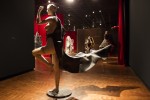Artist Vivan Sundaram meshed together the names Lady Gaga and “Waka Waka (This Time for Africa)” by Shakira to create the fictional brand name “Gagawaka.”
The Fowler Museum’s “Making Strange: Gagawaka + Postmortem” is a two-part exhibition by Delhi-based contemporary artist Sundaram running from April 19 through Sept. 6. The exhibition, which marks the first time that Sundaram’s “Gagawaka” and “Postmortem” have been presented together in North America, is co-curated by art history associate professor Saloni Mathur as well as professor and chair of the Department of Art History, Miwon Kwon.
“Gagawaka” focuses more on fashion and consists of around 30 sculptural garments made out of recyclables, repurposed materials and medical supplies, Mathur said.
“The second component of the show (‘Postmortem’) is a leaving of the garments behind and a return to focus on the mannequin and the human body,” Mathur said. “‘Postmortem’ consists of sculptural assemblages made of mannequins and anatomical models.”
Mathur said she first saw Sundaram’s “Gagawaka” at an art institution in Delhi, India in 2011, where the project was initially a fashion show involving dancers and models. After presenting the fashion show, Sundaram returned to his studio and created “Postmortem” two years later, she said.
“When I saw that fashion show, I immediately thought that this body of work would make so much sense in Los Angeles because of Hollywood and its fashion and glamour,” Mathur said.
“Gagawaka” consists of commonplace items such as rubber tires, plastic drainpipes and handbags, as well as medical supplies like X-ray film, surgical support bandages and pills. Mathur said the garments made from the medical materials raise questions concerning health and illness.
“What’s striking about those old couture garments is that they’re really funky and fabulous and made up of really wild materials,” Mathur said. “There’s also a whole range of what I would describe as very intimate materials which give some of the garments a kind of erotic charge.”
Some of the garments consisting of these more intimate materials include a men’s suit made of women’s sanitary pads, “Wedding Outfit,” and a women’s piece made entirely out of men’s jockstraps, “J S Lingerie.”
“There’s this kind of reversal of very intimate, gendered materials that are turned into garments of the opposite sex and that’s a complicated theme in the show – the question of sexuality,” Mathur said.
Mathur said “Postmortem” is in dialogue with the fashion aspect of the exhibition, but concentrates more on the human body itself and raises questions about sexuality, illness and death.
“A postmortem is a kind of an autopsy and Sundaram said he wanted ‘Postmortem’ to put the spectacle of fashion to death,” Mathur said. “’Postmortem,’ I would describe as much darker and uses a lot of surrealist and post-surrealist techniques.”
In addition to choosing pieces, Mathur said the two curators were involved in the installation process along with the museum’s staff and Sundaram, who flew in from Delhi for the final week of the exhibition’s installation.
“The key curatorial challenge for us was to think about how to create this dialogue between these two bodies of work within the 5,000 square feet of exhibition space,” Mathur said.
Kwon said that although “Gagawaka” was originally presented in a runway setting, they decided to stick to the Hollywood influence.
“One idea we had at the beginning was to make allusions to the red carpet, like a movie opening,” Kwon said. “That idea converted into the use of the red curtains in the gallery to divide the space up.”
“Making Strange” at the Fowler will mark the first time the show will be exhibited in North America said Fowler Museum curatorial assistant, exhibition tour guide and art history graduate student Tracy Buck.
“(The exhibition) is a really thought-provoking show that you can see a number of times and get a number of different things out of it – there’s a lot of different levels to experience,” Buck said.
Mathur said the ambiguity of “Making Strange” allows it to be read in a multitude of ways. There are hundreds of little messages and a lot of it is very playful, she said.
“It’s about the relationship of human creativity in the form of fashion and clothing with basic elements of humanity,” Mathur said, “which are reducible to our bodies, sexualities, demise and death.”
